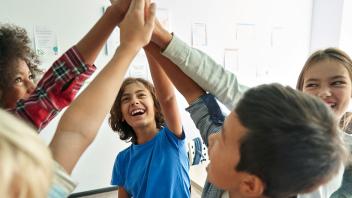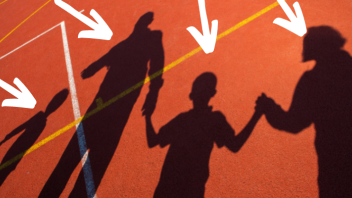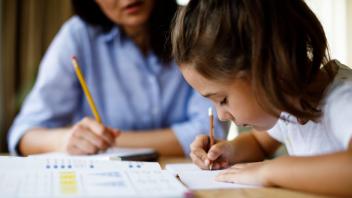ABC, 123, SEL …
In school, every little kid needs to learn their ABCs and their basic numbers. They learn to read and to write. As they get older, they do experiments around the scientific method and learn how to look back at history to better understand the world today.
As part of that basic curriculum, students — of all ages — are also being taught SEL … social-emotional learning. You are probably hearing a lot about SEL these days as more and more teachers, administrators, and parents are understanding the power of SEL as an essential part of every class, assignment, project, and unit; SEL is not an add-on. SEL is also being incorporated into a school’s climate, discipline policies, and teacher professional development.
Teaching SEL in and beyond the classroom is not a trend or an elective, rather a necessity. SEL is fundamental to academic and “life” success.
What is SEL?
SEL reflects the critical role of positive relationships and emotional connections in the learning process and helps students develop a range of skills they need for school and life.
The five core competencies of SEL include:
- self-awareness
- self-management
- social awareness
- relationship skills
- responsible decision-making
All of these skills are necessary — both for educators and students — to function well in the classroom, in the community, and in college and careers.
What sort of skills does SEL help children develop?
SEL is a process for helping children develop fundamental knowledge, skills and attitudes for life effectiveness. SEL teaches the skills we all need to handle ourselves, our relationships, and our work effectively and ethically such as:
- developing healthy identities
- managing emotions
- achieving personal and collective goals
- feeling and showing empathy for others
- establishing and maintaining supportive relationships
- making responsible and caring decisions
- handling challenging situations constructively and ethically
When integrated into academic lessons and practiced to enhance the climate of a school, everyone wins. Out-of-school time providers and parents can reinforce SEL skills as well.
Why is SEL important?
SEL takes into account the whole child. Taking a holistic view of education — from teaching kids their ABCs and numbers to how to share and make sound decisions — instills in children the value of education and human connection. When kids learn and develop these core concepts, they feel a sense of purpose and an ownership in who they are and who they want to be at school, at home, and in their communities.
The more students learn how to understand and manage their own emotions, set and achieve positive goals, and feel and show empathy for others, the greater their ability to become inclusive, caring global citizens.
Video: It’s Time to Stop Calling SEL “Soft Skills”
Research shows that SEL has academic, career, and lifelong benefits. (Edutopia)
SEL is not just for students
It’s important to note that SEL is not just for students. School leaders and their staff need to constantly model and cultivate their own social-emotional competencies. By doing so, they can successfully build a school culture that values the social and emotional aspect of education.
SEL can also help educators with students who struggle in school, especially those who face harsh circumstances on a daily basis, such as racism and other forms of trauma. When embedded into classroom routines, curriculum, and instruction, SEL can be used as a way for teachers and students to build caring, trusting relationships with each other, in which teachers focus on students’ strengths rather than their learning differences and challenges.
SEL in school DNA
ABCs, yes. Learning numbers, yes. Science, math, history, literature, arts, yes. SEL, yes.
What does it look like in the classroom?
Incorporating SEL into the classroom can start small. Read about some fun, easy ways to start here: 25 Ways to Integrate Social Emotional Learning .
A great by-product of SEL is that it not only creates the foundation for life-long learning but also stimulates the development of our most critical interpersonal skills; the ability to work collaboratively, show empathy for others, and communicate respectfully with people of all different backgrounds and experience.
SEL in the classroom can range from using STOP (stop, take a breath to calm down, observe the situation, and proceed with a solution) to teach students strategies whey they encounter an emotional situation to reading books in class that not only boost comprehension but also introduce students to diverse authors, characters, and emotions.
Here are tips on how to weave in SEL strategies all day long: Maslow Before Bloom Throughout the Day .
Here is an example of how to integrate SEL into writing instruction .
In this article, 10 Powerful Community-Building Ideas , you’ll find strategies for ensuring that students in every grade feel like they’re part of the classroom community. See one of the strategies, Shout Outs, in action in the classroom:
These are just a few examples of how teachers and administrators weave SEL into their classrooms and school environments.
Taking Care: An Educator Guide to Healthy Habits for Student Emotional Wellness
This guide contains best practices and activities to optimize mental fitness and emotional resilience and decrease stress and anxiety. (From the First Book Accelerator project) Taking Care guide
Featured video
Voices of Experts: Dr. Christina Cipriano
Christina Cipriano, Ph.D. is an Assistant Professor at the Yale Child Study Center and is the Director of Research at the Yale Center for Emotional Intelligence (YCEI). Dr. Cipriano is an Applied Developmental and Educational Psychologist. Her research focuses on the role of social and emotional learning (SEL) in the promotion of pathways to optimal developmental outcomes for traditionally marginalized student and teacher populations. See our full interview with Dr. Cipriano
Learn more about SEL
Social-Emotional Learning
5 Myths About Social-Emotional Learning
Social-Emotional Learning
What Does ‘Social Emotional Learning’ Really Mean?
Classroom Management
SEL printables to share with your students’ families
Social-Emotional Learning
Navigating Social and Emotional Learning (SEL) from the Inside Out
Social-Emotional Learning
Collaborative for Academic, Social, and Emotional Learning (CASEL)
Social-Emotional Learning
Social & Emotional Learning (SEL)
Browse our social-emotional learning resource library
Learn more about how to nurture social-emotional learning for kids through our articles, tips for parents, video, and research briefs. Visit our Social-Emotional Learning section



